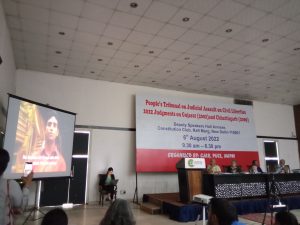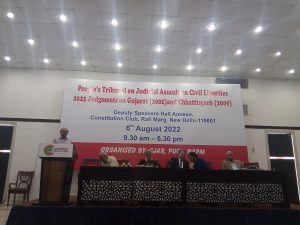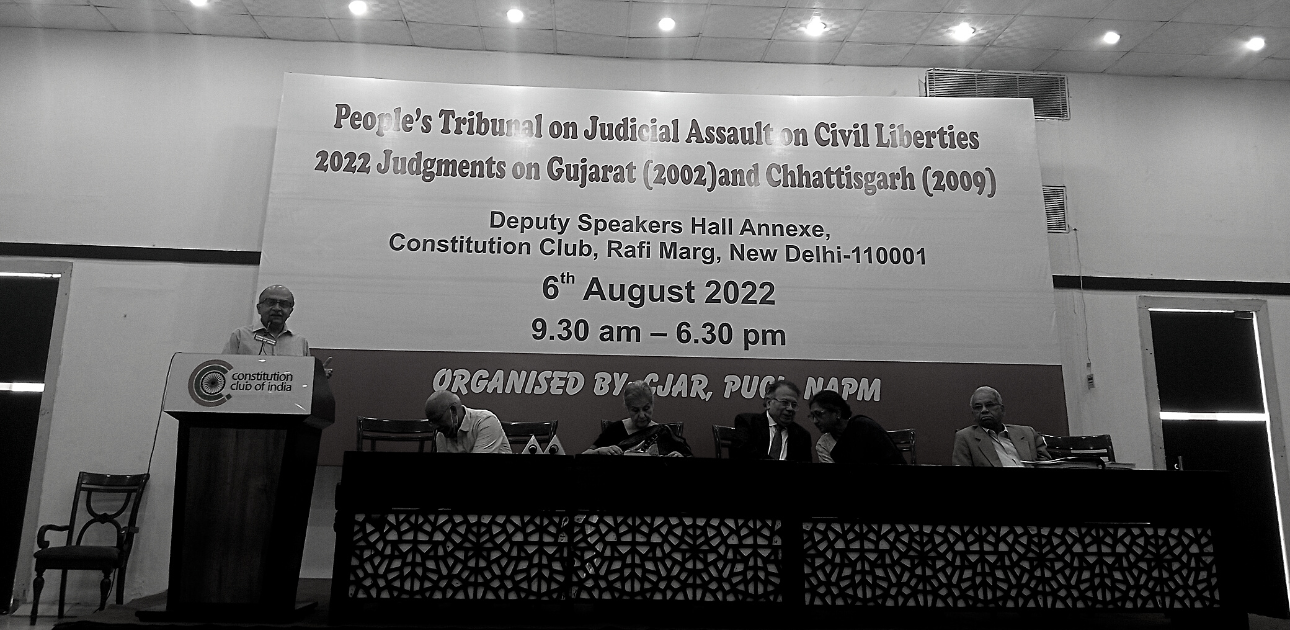The panel of retired judges and eminent persons were disappointed with the recent judgments of the Supreme Court that rolled back constitutional protection and India’s rich jurisprudence on civil liberties.
——
ON August 6, Senior Advocate Colin Gonsalves of the Supreme Court, speaking in presence of a panel of retired judges and eminent persons of the People’s Tribunal on the ‘judicial assault on civil liberties’, remarked with anguish that the Supreme Court has given five Emergency-era judgments in the recent past. These are namely, Vijay Madanlal Choudhary & Ors versus Union of India & Ors(2022), Zakia Ahsan Jafri versus State of Gujarat & Anr(2022) (‘Zakia’), Himanshu Kumar & Ors versus The State of Chhattisgarh & Ors(2022) (‘Himanshu Kumar’), M.C Mehta versus Union of India & Ors(2020) and National Investigation Agency versus Zahoor Ahmad Shah Watali(2019).
The People’s Tribunal, constituted by the Committee on Judicial Accountability(‘CJA’) along with the People’s Union of Civil Liberties (‘PUCL’) and the National Alliance of People’s Movement(‘NAPM’), provided an opportunity to those affected by the Himanshu Kumar and Zakia judgments to offer their testimonies in the presence of the eminent members, namely, Justice AP Shah (Former Chief Justice, High Court of Delhi and former chairperson, Law Commission of India), Justice Anjana Prakash (Former Judge, Patna High Court), Justice Marlapalle (Former Judge, Bombay High Court), Professor Virginius Xaxa (Chairperson of the 2014 High-Level Committee to Examine the Status of STs) and Dr. Syeda Hameed (Former Member of the Planning Commission).
The proceedings of the People’s Tribunal were divided into four sessions. In the first session, the Tribunal was introduced by Supreme Court advocate, Prasant Bhushan. This was followed by an overview of Himanshu Kumar’s judgment and the testimonies of the victims. The deliberation in the second session began with the testimony of Tanveer Jafri, son of late Ehsan Jafri who was murdered in the Gulberg Society massacre, followed by the discussion on Zakia’s judgment by senior advocate, Bombay High Court, Mihir Desai, and Supreme Court advocate Nizam Pasha.
Himanshu Kumar judgment criminalises us all
The first session entirely focused on the repercussions of the Himanshu Kumar judgment, in which the writ petition had alleged that the Chhattisgarh Police, Special Police Officers (SPOs), the activists of Salwa Judum (group of vigilantes sponsored by the Chhattisgarh Government) and the paramilitary forces consisting of the Central Reserve Police Force and the CoBRA Battalions were responsible for the brutal massacre of the tribals in Dantewada district in 2009. The petition was rejected by the division bench of the Supreme Court comprising Justices A.M Khanwilkar and J.B. Pardiwala on July 14. Justice Khanwilkar retired on July 29.

The petitioners including Kumar had prayed for the court to transfer the investigation to the Central Board of Investigation(‘CBI’). However, their prayer was rejected by the court observing that the case does not warrant any further investigation by the CBI into the First Information Report(‘FIR’) registered by the petitioners. Moreover, an exemplary cost of ₹5 lakhs was imposed on Kumar.
The kith and kin of the victims and eyewitnesses of the September 18 and October 1, 2009, anti-Naxal operations in Chattisgarh (also referred to as Operation Green Hunt), in which 16 tribals were allegedly massacred in the villages of Gachhanpalli, Gompad, and Belpocha in the Dantewada district, gave their testimonies before the Tribunal.
Justice Anjana Prakash, Former Judge of Patna High Court, asked one of the witnesses how were they able to identify that the people who came and shot Adivasis were members of security forces. One of the witnesses replied, “We know because they would often come to the village in their uniform.”
The tribunal was concerned about the status of the dead bodies and wanted to know if postmortems were conducted. Kumar, who runs the Vanvasi Chetna Ashram in Dantewada, told the tribunal that no postmortem was done since most of the villagers had simply buried the bodies.
It should be noted that the Tribunal members did not have the copies of FIRs and charge sheets filed by the police on the basis of which the Supreme Court had rejected the petitions. Justice Anjana Prakash asked, “these are public documents. How can we not have these?” In this regard, Kumar also told the tribunal that no statements of eyewitnesses were recorded by the police and that is why they have not got the FIR copies since they had intentionally named villagers as Naxalites.
Kumar said: “People are being declared and then killed as Naxalites. But in reality, these people are not Naxalites”. After the massacre was committed, Kumar, along with his team, had set up a fact-finding inquiry to investigate the atrocities and approach the court to get justice.
Gonsalves found it shocking that the Supreme court, instead of appreciating the courage of these people, chose to impose a fine on them. “When an NGO takes up such cases, the judges nowadays say that they should be fined. I am extremely shocked by the working of the courts.”
Justice AP Shah also expressed his disappointment by saying, “instead of appreciating the courage of the tribals and ordering an in-depth inquiry, the Supreme Court penalised them.”
Zakia’s judgment’s clean chit
The second session started with a powerful testimony of Tanveer Jafri, son of late Ehsan Jafri and former Member of Parliament. Ehsan Jafri was pulled out of his house by the riotous mob and was gruesomely hacked to death during the post-Godhra carnage in Ahmedabad along with 69 others, who had taken refuge in their house, in 2002.
The Supreme Court, in Zakia, ruled out any criminal conspiracy and complicity of the state officials that had led to the carnage against minorities in Gujarat in 2002 and thereby rejected the protest petition of Zakia Jafri, widow of the late Ehsan Jafri, against the probe carried out by the Supreme Court-appointed Special Investigation Team (‘SIT’) which did not investigate the conspiracy angle.
Subsequent to the Supreme Court’s judgment, the arrest of activist Teesta Setalvad and whistleblower and former Director General of Police, R.B. Sreekumar took place. Tanveer, commenting on the harassment faced by activists, said that it’s sad that they have been arrested for doing their job. Advocate Nizam Pasha said that the tone of the judgment questions the audacity of the petitioners, as it asked: “how did the petitioners have the audacity to question the authority of the state?”
Commenting on the absurdity of the judgment, he further told the tribunal that they (petitioners) only wanted the court to consider whether the state conspired to create the circumstances that had made the people extremely agitated and, “all that was needed was a matchstick to light the fire”.
“We did not pinpoint any accused. But the court reduced the judgment in such a way that it revolved around giving a clean chit to the former Chief Minister. Supreme Court, instead of allowing the people to question the working of the state, is criminalising the people who are questioning them“, he added.
Convictions even before the trial begins
Mihir Desai said that, in both Himanshu Kumar and Zakia, the conviction has been handed down to the alleged persons even before the trial began.
Further, he expressed his regrets over the remarks of the Supreme Court against Teesta Setalvad and others. According to him, the Supreme court’s observation that the pot has been kept boiling for so many years, is not true. It started as soon as the riots took place, he said. “On March 1, 2002, the National Human Rights Commission took a suo moto action just after three days of the riots. They visited Gujarat for three-four days. They had mentioned in the report that the law and order situation had completely collapsed… the pot did not start boiling in 2006. It started way back”, he concluded.
No confidence in the Supreme Court
Senior advocate and Member of Rajya Sabha, Kapil Sibal, expressed his dismay with the Supreme Court’s functioning and its judgments. “There is a huge difference between what the Court says and what is happening on the ground”. Giving the example of the rampancy of hate crimes and hate speeches, Sibal said, “There is no investigation. There are no directions by the Supreme Court. Even when the perpetrators are arrested, they are granted bail within a day.”

Referring to the Gulberg Society massacre, Sibal said, “When the people and the place was being burnt, the intelligence agency called the fire brigade, but not a single call was answered. We questioned the SIT on why was this not investigated. The SIT failed to investigate the obvious larger conspiracy involved.” Sibal stated this as one of the examples of the failure of the SIT to perform its duties.
The authenticated tapes were not relied upon to hold the perpetrators guilty, Sibal said. He further remarked, “The SIT believed the accused, the investigation was concluded, and the accused were released. What kind of law is this? There must be prosecution of the accused and presenting defence evidence. The claims of the accused persons that their statements in tapes were exaggerated or that they were forced to read and speak were all approved and believed by the Supreme Court.”
On a critical note towards the functioning of the Supreme Court, Sibal said, “There is no system in courts. There is no independence in the institution of courts. Sensitive cases are strategically placed before certain judges. Nowadays, arrest precedes investigation” According to Sibal, the charge of criminal conspiracy under Section 120B of the Indian Penal Code, 1860 is applied loosely for the purpose of denying bail, and the judge demands that the accused should be proved innocent to be granted bail. “There is no confidence in a system where this law is upheld by the court.”
We need to analyse the current situation differently, and not by analysing the Supreme Court judgments, Sibal stated. Sibal claimed that only the change in social mindset would restore independence to institutions.
Lastly, Sibal addressed the issues arising from the Supreme Court’s judgment, also authored by Justice Khanwilkar close on the heels of his retirement, upholding various provisions of the Prevention of Money Laundering Act, 2002 (‘PMLA’), thereby affirming the powers and jurisdiction of ED. Sibal said, “ED is the most dangerous institution. It has crossed its limits in violating individual liberties.” He asked: “How can the Supreme Court say PMLA is not a penal statute? The definition of ‘proceeds of the crime’ itself mentions crime and crime is penal.”
Under critical scrutiny
In her address, well-known senior advocate, Nitya Ramakrishnan, stated there are three ways in which the functioning of the judiciary, in recent times, can be analysed – through its abdication, distortion, and active balefulness towards civil society.
Explaining abdication with the example of abrogation of Article 370 of the Constitution, Ramakrishnan said, “Hundreds of activists are in jail. The Habeas Corpus petitions are pending. The Supreme Court has not decided on the challenge to the abrogation of Article 370. We do not know when it will be heard or whether it will be heard at all.” Ramakrishnan claimed the prevalence of the distortion of principles of jurisprudence and of facts and laws. “Established norms of evidence are being distorted in legislation after legislation which the Supreme Court is endorsing, as seen in the PMLA judgment”, Ramakrishnan said.
Lastly, Justice Prakash remarked that since we are living in a democratic setup where the courts are being paid from the taxpayers’ pockets; therefore, there must be a constant demand for justice.


